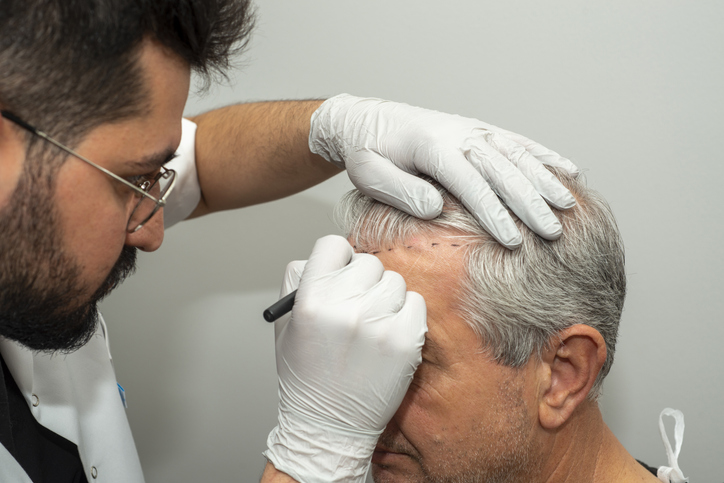What is Direct Hair Transplant Technique?
DHT, or Direct Hair Transplantation, is an advanced adaptation of the FUE (Follicular Unit Extraction) method, a technique that’s rapidly becoming the choice for those combatting hair thinning. In the DHT method, individual hair follicles are delicately extracted from the donor region using a specialised extractor tool, no larger than 1mm in diameter. These follicles are immediately transplanted into the designated area using a bespoke implanting device. This specific tool ensures unparalleled precision in terms of depth, angle, and direction, promising an utterly natural appearance.
While DHT shares many similarities with the traditional FUE process, including a quick recovery and minimal scarring, it boasts a distinctive feature: the entire procedure is exclusively performed by accredited surgeons. This contrasts with the FUE and FUT methods, often overseen by technicians. The outcome is naturally-growing hair that harmoniously blends with your existing locks, affording you the liberty to trim, groom, and style as you wish.
How is Direct Hair Transplantation Different from FUE?
Both Direct Hair Transplantation (DHT) and Follicular Unit Extraction (FUE) stand as leading methods within the realm of hair restoration, each boasting its distinct approach and benefits in addressing hair loss.
The Follicular Unit Extraction (FUE) procedure meticulously extracts individual follicular units (comprising 1 to 4 hairs) from the donor region, typically the back and sides of the head. These units are subsequently implanted into areas showing signs of balding or thinning. A hallmark of FUE is its ability to bypass noticeable scarring in the donor region, ensuring a swifter recovery and offering a less invasive alternative to other methods, such as Follicular Unit Transplantation (FUT). A pivotal stage in FUE involves the crafting of small channels in the recipient zone using precision micro-motor instruments before placing the harvested grafts.
Conversely, Direct Hair Transplantation (DHT) offers a more streamlined approach. In this method, the slit-making, extraction and implantation is done simultaneously. Significantly increasing the survivability of each graft as well as reducing the out-of-body time for each graft. The efficiency is achieved with a large team that works with the surgeon during the procedure. The standout advantage of DHT, perfected over the years since its inception by the Founding Surgeons, gives the remarkable results that are available online.
In summary, the salient distinctions between DHT and FUE encompass:
Implantation Technique: While FUE necessitates pre-made slits in the recipient area before grafting, DHT, does the entire process of slit-making and then the extraction and implantation simultaneously.
Exposure Duration: DHT ensures grafts experience minimal time outside their natural environment, thus likely fostering better follicle survival compared to FUE.
Professional Involvement: Often, FUE can be administered by trained technicians, whereas DHT, given its intricate nature, is typically overseen by a certified surgeon.
How Does a Direct Hair Transplant Unfold?
The Initial Steps: Preparation and Anesthetic Application
To commence, the clinical team will tidy up your scalp, cropping the hair in the designated donor region. Subsequent to this grooming, local anaesthetic is applied to guarantee a sensation-free experience. The specialist then delicately harvests individual hair follicles from the donor site, often the rear of your scalp, employing a finely-calibrated instrument.
The Implantation Phase: Detail-Oriented Insertion
Following extraction, the follicles are recorded and implanted. Each one is seamlessly embedded directly into the thinning sections in the slits made by the surgeon. The approach ascertains each follicle nestles in with the optimal depth, orientation, and trajectory, ensuring an impeccably natural appearance.
The Journey: Anticipation Meets Result
Typically, a DHT session spans roughly 8 hours, though this can oscillate depending on the count of follicles being relocated. The true splendour of the transplant graces one’s sight between 12 to 18 months post-procedure, unveiling a luxuriant and authentically full mane.
Why Opt for DHT for Your Hair Restoration?
- Reduced Exposure: Grafts encounter notably less time in external conditions, thereby enhancing the vitality and efficacy of graft placement.
- Remarkable Survival Odds: This technique boasts a commendable follicle survival rate, heralding a triumphant transplantation.
- Minimal Disruption: With DHT, there’s scarcely any bleeding during the creation of the recipient zone and diminished trauma whilst handling grafts. This minimises disturbance to the area’s circulatory system.
- Prompt Convalescence: The methodology champions a rapid recovery, empowering patients to promptly re-engage with their daily affairs.
- Maintaining Natural Elegance: Contrary to some alternatives, DHT spares the recipient site from shaving, enhancing convenience for many.
- Authentic Results: DHT pledges entirely natural outcomes, creating a harmonious merger with one’s existing locks at reasonable hair transplant cost.
- Free from Blemishes: The technique sidesteps the need for stitches and incisions, thus eliminating any trace of scarring – a delightfully non-intrusive journey.
- Comfort First: Experiencing DHT is predominantly devoid of discomfort, making it a sought-after choice for those keen on a serene experience.
- A Flourishing Future: Celebrating a follicle survival rate that often surpasses 90%, DHT ensures the thriving nature of a vast majority of transplanted strands.
- Brief Respite: Championing a swift convalescence, DHT lets individuals resume their daily ventures in no time.
- Economising on Donor Strands: The modus operandi demands fewer donor hairs, proving a boon even for those with scanty donor resources.
- Meticulous Growth: DHT gives surgeons the capability to finetune the trajectory and scale of hair growth.
- Stellar Success Rate: Sporting a sterling success rate around 95%, DHT stands out as a gold standard in hair restoration endeavours.
Who Stands to Benefit Most from DHT?
DHT proves invaluable for those grappling with advanced stages of hair thinning. Those who’ve been navigating the challenges of pattern hair loss for upwards of five years might find DHT to be a game-changer. Additionally, for those left disheartened by the limited success of medical hair restoration treatments, DHT emerges as a promising alternative.
Specific scenarios where DHT shines include:
- Refining the Forefront: Those seeking to chisel their hairline will find DHT adept at crafting a naturally abundant look at the forefront.
- Eyebrow Restoration: For those with aspirations of lusher and more defined eyebrows, DHT can work wonders.
- Facial Hair Enhancement: Whether it’s a beard or moustache that needs bolstering, DHT is tailor-made for the job.
- The Non-shaven Preference: For patients averse to the idea of shaving prior to the procedure, DHT is an accommodating fit.
- Aiming for Density: For those with visions of luxuriant, natural tresses in areas that have seen better days, DHT is the sought-after answer.







